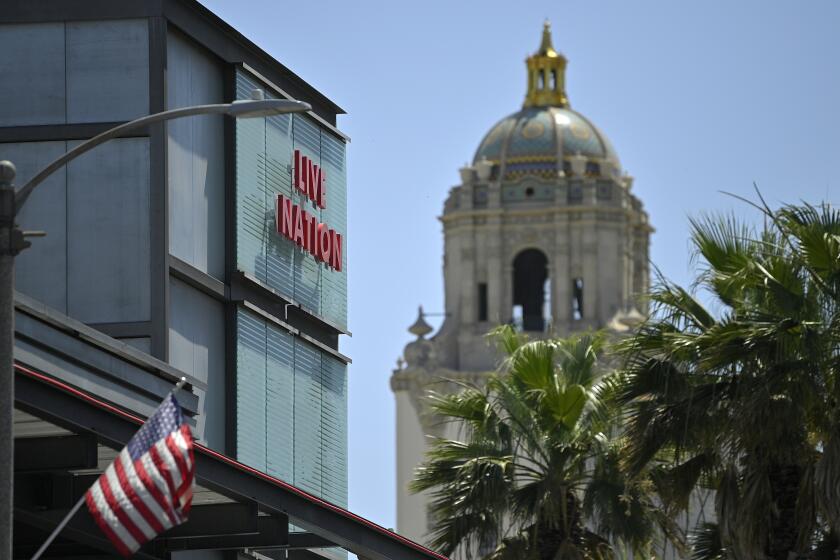A Musical Look at Other Side of Andy Warhol : Album: Lou Reed and John Cale, partners in Velvet Underground, collaborate again to repay a debt in a 15-song biography of their mentor.
- Share via
The late Andy Warhol, who prospered in part by creating portraits of the famous, is now on the receiving end. The medium is music, and the artists are two essential rock figures whose careers Warhol helped launch 25 years ago.
The work is “Songs for Drella,” a 15-song biography of the Pop Art icon that marks the first collaboration by Lou Reed and John Cale since their stormy partnership in the Velvet Underground, the band that Warhol shepherded into rock legend in the swinging ‘60s.
“Drella,” which is due in stores today, is a historical and psychological study of theartist from his childhood to his death at age 58 in 1987. It chronicles Warhol’s ascent in the art world, outlines his aesthetic philosophy, captures his personal quirks, world view and deadpan tone, and makes chillingly palpable the isolation and uncertainty that descended on him after he was shot by a deranged hanger-on in 1968.
Reed sees the album as an antidote to what he calls calls “the spate of opportunistic, negative, vile books about Andy.”
During a recent interview in the Burbank offices of Warner Bros. Records, Reed, 46, explained the motivation: “It doesn’t seem the general public is being given any information to counteract this by someone who knew him and cared about him, so we decided we should do that. To give another point, another look at him.”
Cale, 49, and Reed had already gotten together to play informally when the idea for the Warhol project evolved from a friend’s suggestion that Cale write a Mass for their friend. After determining the chronological structure and seven thematic areas, the two acquired backing from two New York organizations--the Arts at St. Ann’s and the Brooklyn Academy of Music--and dug in.
“It was really hard, rewriting it,” said Reed. “Like, what is the song really about? How do you really feel about it? How far do you want to go with this?
“It was really interesting for me. I found out more than I cared to know. But in another way it was kind of nice. I closed the door on certain things. Of course, I didn’t get to talk to Andy, because he went and died. That’s the crux. The record still can’t do that, that I know about. And I’ll never get a chance to say thank you.”
Reed’s estrangement from Warhol is depicted unflinchingly on the record, and the singer expresses his profound regret in “Hello It’s Me,” a soul-baring valediction that ends the album. But in person, Reed proved capable of avoiding some topics as tenaciously as he dug into others.
“Well, that’s in the album,” he said of his break with Warhol. “I can’t talk about that. It’s personal stuff. I figured out just how far I wanted to go, and that’s in the album.”
The roots of the Reed-Cale-Warhol relationship go back to November of 1965, when Warhol went to a Greenwich Village tourist dive called the Cafe Bizarre to see a quartet called the Velvet Underground, which played five or six sets a night of edgy, dark-themed music. The artist invited the band to join him at his upcoming appearance at the old Cinematheque in New York. They could play and he’d project his films on them. Before long, Warhol was the Velvets’ manager and producer.
“The only way we could get hired was through Andy,” Reed recalled. “We were a zero, we were non-existent. The only jobs we had were playing art festivals with Andy. They were always calling Andy to do an art festival and show his films, and instead of doing that he would show up with the films and us. He wanted to get into rock ‘n’ roll, and we were perfect for him.”
Reed wasn’t crazy about Warhol’s installation of the German model Nico as lead singer, but he gives him full credit for establishing the band as a major, lasting influence in rock.
“He had this amazing ability to make things happen. He also protected us. He made it possible for that first Velvet Underground record to come out as a Velvet Underground record, not changed around by outside forces.
“Just because he was Andy and he said, ‘Oh, that’s great,’ these other people would leave the tape alone. And that set kind of a standard for Velvet Underground records after that. He was like this umbrella. It kept other people from tampering with the thing.”
The “Drella” album is a major shift of gears for Reed, who’s coming off his most critically acclaimed and commercially successful LP in years, “New York.” In contrast to that hard-rocking opus, “Drella” is just Reed and Cale, sawing and hammering on keyboards, guitars and viola.
“It was very important that it be John and I and nobody else,” said Reed. “I want you to hear clearly without anything getting in the way of it. ‘Cause that’s what’s unique about it. It’s me playing with John Cale, and bringing in anything else makes it less clear and harder to hear. For better or for worse, this is what we sound like playing together and talking about Andy.
“I think a record can bring you closer than possibly anything. I always picture someone listening to it alone at night. And if you do that then it’s like a story is being told to you with music illustrating it. You can get deeper and deeper into this person. I wanted you to come away feeling you met somebody.”
RELATED STORY: F3
More to Read
The biggest entertainment stories
Get our big stories about Hollywood, film, television, music, arts, culture and more right in your inbox as soon as they publish.
You may occasionally receive promotional content from the Los Angeles Times.










